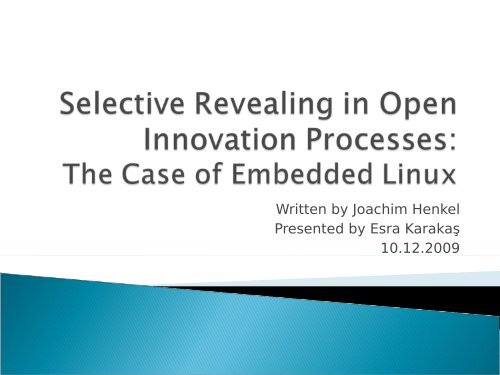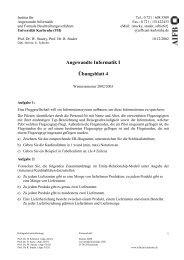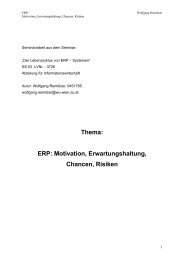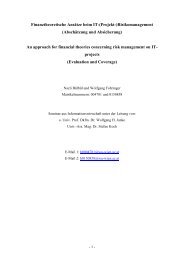Selective Revealing in Open Innovation Processes: The Case of ...
Selective Revealing in Open Innovation Processes: The Case of ...
Selective Revealing in Open Innovation Processes: The Case of ...
Create successful ePaper yourself
Turn your PDF publications into a flip-book with our unique Google optimized e-Paper software.
Written by Joachim Henkel<br />
Presented by Esra Karakaş<br />
10.12.2009
Introduction<br />
Literature Review<br />
Research Questions<br />
Hypotheses<br />
Research Design and Data<br />
Results and Discussion<br />
<strong>Selective</strong> <strong>Reveal<strong>in</strong>g</strong> Example<br />
Conclusion
In open <strong>in</strong>novation processes, technology is<br />
treated as a tradable good to be bought and<br />
sold on the market (Arora, 2001)<br />
Under suitable circumstances, firms may<br />
make their technology available to the<br />
public <strong>in</strong> order to elicit development<br />
collaboration, but without any contractual<br />
guarantees <strong>of</strong> obta<strong>in</strong><strong>in</strong>g it.
In this paper, if and under what conditions<br />
openness leads to open <strong>in</strong>novation are<br />
<strong>in</strong>vestigated.<br />
Embedded L<strong>in</strong>ux is chosen s<strong>in</strong>ce it<br />
◦ Is nearly exclusively developed by commercial<br />
firms<br />
◦ Comes under an OSS license<br />
◦ Is <strong>of</strong> highest relevance for manufacturers <strong>of</strong><br />
embedded devices
Analyzed by von Hippel (1987), Schrader<br />
(1991), Dahl and Peterson (2004).<br />
Despite the lack <strong>of</strong> formal contractual<br />
agreements, the <strong>in</strong>formation provider expects<br />
her counterpart to reciprocate.<br />
Similar to reveal<strong>in</strong>g OSS code <strong>in</strong> terms <strong>of</strong><br />
gatekeeper position <strong>of</strong> <strong>in</strong>dividual developers<br />
◦ <strong>The</strong> difference is that <strong>in</strong> trad<strong>in</strong>g, <strong>in</strong>fo is given to one<br />
recepient which makes easier to understand a lack <strong>of</strong><br />
reciprocation.
Focused on free reveal<strong>in</strong>g by firms or <strong>in</strong>dividuals<br />
that expect to benefit from use rather than sale <strong>of</strong><br />
<strong>in</strong>novations.<br />
Motivated to do so by expectations <strong>of</strong> benefit from<br />
development support by a user community and/or<br />
build<strong>in</strong>g reputation among peers<br />
However, it is not the case.<br />
◦ Firms develop<strong>in</strong>g embedded L<strong>in</strong>ux are not users <strong>of</strong> the<br />
s<strong>of</strong>tware, but manufacturers (or suppliers to those) <strong>of</strong><br />
goods conta<strong>in</strong><strong>in</strong>g embedded s<strong>of</strong>tware.
Collective <strong>in</strong>vention differs from OSS development <strong>in</strong><br />
terms <strong>of</strong> R&D s<strong>in</strong>ce the firms did not allocate resources to<br />
<strong>in</strong>vention<br />
◦ Corresponds to user-development <strong>of</strong> OSS<br />
In collective <strong>in</strong>vention, all firms follow the same goal as <strong>in</strong><br />
the case <strong>of</strong> iron furnaces (Allen, 1983) and pump<strong>in</strong>g<br />
eng<strong>in</strong>es (Nuvolari, 2001)<br />
Thus idea is related but dist<strong>in</strong>ct from collective <strong>in</strong>vention.<br />
◦ S<strong>of</strong>tware development is a part <strong>of</strong> R&D<br />
◦ Heterogenity <strong>of</strong> needs supports the collaboration
Sett<strong>in</strong>g a standard and<br />
enabl<strong>in</strong>g compatibility<br />
Increas<strong>in</strong>g demand for<br />
complementary goods and<br />
services<br />
Benefit<strong>in</strong>g from external<br />
development support<br />
Signall<strong>in</strong>g technical<br />
excellence or good OSS<br />
citizenship<br />
<br />
<br />
<br />
S<strong>of</strong>tware that is freely<br />
available to anyone can no<br />
longer be sold<br />
S<strong>of</strong>tware revealed as OSS<br />
can be used also by<br />
competitors<br />
<strong>The</strong> firm orig<strong>in</strong>ated the<br />
s<strong>of</strong>tware might lose control<br />
over its further<br />
development<br />
Benefits<br />
Downsides
To m<strong>in</strong>imize the downsides <strong>of</strong> public OSS<br />
development<br />
◦ Choose “non-copyleft” OSS licences or use an<br />
OSS and a proprietary licence <strong>in</strong> parallel<br />
(Behlendorf 1999, Hecker 1999, Raymond 1999)<br />
◦ Use <strong>of</strong> “standard” means <strong>of</strong> protection - legal<br />
mechanisms, secrecy, lead time, complementary<br />
assets (Dahlander and Magnusson, 2005)
<strong>The</strong> results leave an important gap<br />
◦ In the case <strong>of</strong> s<strong>of</strong>tware development based on exist<strong>in</strong>g OSS<br />
under the GPL, the protection mechanisms become<br />
unavailable<br />
◦ No study exists for the decision to reveal code or not on the<br />
level <strong>of</strong> <strong>in</strong>dividual code contributions<br />
◦ No empirical quantative study that relates a firm’s reveal<strong>in</strong>g<br />
behaviour to its characteristics exists
What latitude do firms have with respect to reveal<strong>in</strong>g or protect<strong>in</strong>g<br />
the code they develeop for embedded L<strong>in</strong>ux? What means <strong>of</strong><br />
protection do they use and how <strong>of</strong>ten ?<br />
What share <strong>of</strong> the code for embedded L<strong>in</strong>ux that these firms<br />
develop is made public?<br />
What type <strong>of</strong> code is typically revealed? What code is typically<br />
protected?<br />
What are the reasons for firms to make their OSS code voluntarily<br />
public?<br />
How is the degree <strong>of</strong> openness determ<strong>in</strong>ed by firm characteristics?
<strong>The</strong> share <strong>of</strong> code developed for embedded L<strong>in</strong>ux that a<br />
firm reveals to the public is larger...<br />
◦ H1: ... the smaller the firm.<br />
◦ H2: ...if there is a firm policy <strong>in</strong> place that encourages<br />
reveal<strong>in</strong>g.<br />
◦ H3: ... if there is no firm policy restrictive to reveal<strong>in</strong>g <strong>in</strong> place.<br />
◦ H4: ... if there are proprietary complementray assets<br />
available.<br />
◦ H5: ... the longer the firms has been develop<strong>in</strong>g embedded L<strong>in</strong>ux.<br />
◦ H6: ... the more important, as a reason to reveal, considerations<br />
are regard<strong>in</strong>g...<br />
a) development support, b) market<strong>in</strong>g, c) reputation, d) the GPL.
<strong>The</strong> case <strong>of</strong> embedded L<strong>in</strong>ux demonsrates a<br />
repartion<strong>in</strong>g <strong>of</strong> <strong>in</strong>novative activity <strong>in</strong>to an open<br />
and protected part<br />
Web-based questionnaire<br />
◦ 268 valid responses<br />
◦ No <strong>in</strong>dication <strong>of</strong> non-response bias<br />
◦ Type <strong>of</strong> organizations:<br />
S<strong>of</strong>tware company specializ<strong>in</strong>g on embedded L<strong>in</strong>ux<br />
Device manufacturer<br />
Manufacturer <strong>of</strong> components like chips and boards<br />
Hobbyist<br />
University or other non-pr<strong>of</strong>it research organization
A firm can reveal code “sometimes” or only to<br />
its customers<br />
A firm can delay and restrict diffusion by<br />
provid<strong>in</strong>g the source code on demand only, and<br />
without active support<br />
A firm can actively reveal code, but only after a<br />
certa<strong>in</strong> delay<br />
A firm can make drivers available only as<br />
loadable b<strong>in</strong>ary modules, not as source code
* This means <strong>of</strong> protection applies to s<strong>of</strong>tware vendors only. Observations with miss<strong>in</strong>g<br />
data or with a reply “don’t know” are not <strong>in</strong>cluded <strong>in</strong> the calculation <strong>of</strong> percentages.
Focuses on those embedded L<strong>in</strong>ux developments<br />
that are potentially useful for others.<br />
<strong>The</strong> code is actively made public, be it for<br />
download<strong>in</strong>g on a website, as a post<strong>in</strong>g on a mail<strong>in</strong>g<br />
list, or as a submission to the ma<strong>in</strong>ta<strong>in</strong>er<br />
It is found that code shar<strong>in</strong>g by commercial firms <strong>in</strong><br />
the field <strong>of</strong> embedded L<strong>in</strong>ux seems on the way to<br />
becom<strong>in</strong>g ma<strong>in</strong>stream behaviour, not a left-over<br />
from the hype that surrounded OSS <strong>in</strong> 1999 and<br />
2000.
<strong>The</strong> highest agreement is “generic”<br />
◦ S<strong>in</strong>ce reveal<strong>in</strong>g generic code should not harm the competitive<br />
position <strong>of</strong> the company.<br />
<strong>The</strong> positive net agreement on “for our competitive<br />
position” and “to differentiate our product”<br />
◦ This may be the case when reveal<strong>in</strong>g signals the firms’<br />
competencies or when it creates demand for related services or<br />
proprietary s<strong>of</strong>tware<br />
<strong>The</strong> logic <strong>of</strong> complementary assets as a protection<br />
mechanism applies when the code is specific to some<br />
hardware or s<strong>of</strong>tware application
This is done for<br />
hardware<br />
manufacturers<br />
For s<strong>of</strong>tware<br />
manufacturers,<br />
market<strong>in</strong>g rank<br />
much higher<br />
◦ ranks 3 and 6, <strong>in</strong><br />
contrast to ranks 6<br />
and 10 for<br />
hardware
Firm size<br />
◦ <strong>Open</strong> sourse s<strong>of</strong>tware allows small enterprises to afford<br />
<strong>in</strong>novation (H1 confirmed)<br />
Firm policies<br />
◦ Encourag<strong>in</strong>g policy does not exhibit the expected<br />
positive effect (H2 not confirmed)<br />
◦ Restrictive policy exhibits negative effect for some<br />
items (H3 partly supported)
Complementary assets<br />
◦ Device manufacturers reveal but significantly less than<br />
s<strong>of</strong>tware firms (H4 not fully confirmed)<br />
Familiarity with embedded L<strong>in</strong>ux<br />
◦ Captur<strong>in</strong>g a firm’s experience <strong>in</strong> develop<strong>in</strong>g embedded<br />
L<strong>in</strong>ux carries positive coefficient (H5 confirmed)<br />
Company age when it started embedded L<strong>in</strong>ux<br />
◦ Positive and significant <strong>in</strong> all specifications
Reasons to reveal<br />
◦ Those related to market<strong>in</strong>g shows no significant<br />
effect (H6b not confirmed)<br />
◦ Those related to the GPL shows no significant effect<br />
(H6d not confirmed)<br />
◦ Those related with development support and<br />
reputation carry positive coefficients <strong>in</strong> all<br />
specifications (H6a and H6c confirmed)
<strong>Open</strong> source s<strong>of</strong>tware from Turkcell<br />
Technology – Isola Framework<br />
Available on the website - http://<br />
labs.turkcellteknoloji.com.tr/<br />
<strong>The</strong> code provided is generic and Turkcell<br />
expects technical benefits from the open<br />
source development process
Firms have chance to practice “selective<br />
reveal<strong>in</strong>g”<br />
Firms reveal, on average, about half <strong>of</strong> the code<br />
they have developes for embedded L<strong>in</strong>ux, while<br />
protect<strong>in</strong>g the other half.<br />
<strong>The</strong> private-collective model <strong>of</strong> <strong>in</strong>novations is<br />
found to work even <strong>in</strong> this ma<strong>in</strong>ly commercial<br />
environment.<br />
Further research could be done regard<strong>in</strong>g the role<br />
played by employed programmer

















